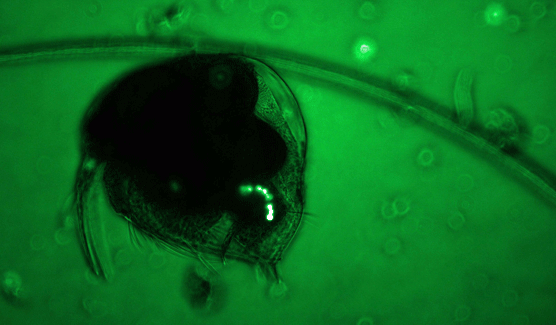Press release 2013-12-02 at 9:00

Researchers at the Finnish Environment Institute have successfully for the first time demonstrated that microplastics are transferred in the marine food web. The study also provided additional support to suspicions that many plankton organisms are unable to separate plastic particles from their natural food and that they therefore also ingest plastic.
“Although polystyrene microspheres were egested by planktonic crustaceans naturally, it is not yet known how plastics of different shapes and sizes found in the environment behave inside the organisms”, says Senior Researcher Outi Setälä from the Finnish Environment Institute.
The findings are from an EU-financed project during which researchers from the Finnish Environment Institute collected microlitter samples from the sea and monitored under laboratory conditions how small plastic particles travel in the planktonic food web.
During the laboratory tests, a number of zooplankton taxa were exposed to 10-micrometre (µm) fluorescent polystyrene microspheres and the zooplankton labelled with ingested microspheres, which included copepods and polychaete larvae, were then offered to larger crustaceans. The tests showed that many species ingested plastic when feeding. The plastic microparticles were transferred via these planktonic organisms from one trophic level to a higher level.
The microlitter samples collected from the Baltic Sea are being analysed at the moment. The results will be published in 2014. Earlier studies conducted on the west coast of Sweden show that the topmost layers of the sea contain a few dozen particles of man-made litter per litre.
The Marine Strategy Framework Directive calls attention to marine litter
Marine litter has attracted increasing attention in recent years. One reason for this is the EU Marine Strategy Framework Directive, which describes the status of the marine environment with the help of eleven indicators, one of which is the volume of marine litter. The indicator covers both larger particles that are visible to the human eye and microscopic litter particles. In the light of current data, the majority of marine litter originates from land and consists of plastic.
Microlitter comprises particles smaller than five millimetres. More attention has only been given to its existence in the last decade.
“Microplastic particles can end up in the sea as a result of industrial discharges or with urban waste water, which can contain microplastics originating from day-to-day consumer goods. For example, some skin peel products and toothpastes include substances that contain tiny abrasive plastic particles. Some marine microplastics are the result of larger pieces of plastic that disintegrate in the sea”, Outi Setälä explains.
Microplastics can be harmful to the marine environment, but there is still little scientific evidence to support this. The biggest problem lies in the fact that it is impossible to remove microplastics from the sea once they are already there. In fact, more and more microplastics enter the marine environment from different sources all the time.
Other problems associated with plastic include its permanence and tendency to absorb harmful substances from the surrounding sea water. Plastic breaks down in the environment extremely slowly.
Efforts needed to prevent the accumulation of microplastics in the sea
“If we do not intervene in the accumulation of microplastics in the sea, we could be contributing to a new kind of environmental issue. Since these plastic particles are the same size as the natural food of many marine organisms, it is possible for microplastics to accumulate in marine food webs through water and benthic communities”, Outi Setälä says.
Setälä’s study is part of an EU-financed project that aims to increase knowledge and provide guidance for harmonised use of descriptors, criteria and indicators in defining good environmental status according to the EU Marine Strategy Framework Directive, especially for those descriptors insufficiently addressed so far, such as food webs, non-indigenous species, marine litter, and underwater noise.
For more information about the EU project, visit
The paper on microplastics written by Outi Setälä, Vivi Fleming-Lehtinen and Maiju Lehtiniemi was published in ScienceDirect and can be found at
For more information, please contact:
Senior Researcher Outi Setälä, firstname.lastname@ymparisto.fi, tel. +358 29 525 1635
Communications Specialist Aira Saloniemi, firstname.lastname@ymparisto.fi, tel. +358 400 148 875